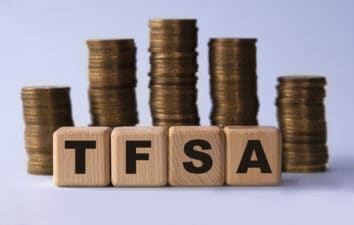I remember the day like it was yesterday — July 17, 1997. It was my first day gainfully employed, as an ice cream maker at the local Dairy Queen.
The job paid $4.50 per hour, which was minimum wage at the time. Although I was opposed to it at first, I quickly embraced working there. Bosses were laidback, food was 50% off, and I earned enough to not really have to worry about money throughout my high school years.
But what if I had done things differently? What if, instead of wasting my money on video games and rounds of golf, I did something smart with it?
Back in July 1997, shares of Toronto-Dominion Bank (TSX: TD)(NYSE: TD) were trading at a split-adjusted level of $10.50 each. What if I took $100 per week of my Dairy Queen earnings and put that money to work in TD shares? What would I have accomplished by the end of 2000, when I quit my first part-time job? Let’s find out.
For simplicity’s sake, I’m going to use an average between the year’s high and low for my share purchase calculation. I’m also going to assume that any dividends were reinvested, and also that there were no commission costs to any of these transactions.
In 1997, I was employed for 24 weeks. My $2,400 would have bought 284 shares at an average of $8.45 per share. I would have accumulated $42.65 in dividends, meaning I would have bought an additional five shares. At the end of 1997 I would have owned 289 shares of TD.
In 1998, I would have contributed the full $5,200. Shares did well at the beginning of the year, before hitting lows in the summer. I would have purchased 567 shares at an average purchase price of $9.16. The original 289 shares would have collected the full $0.335 per share dividend, while the additional 567 shares would have collected half the dividend (since they were being added throughout the year). Total dividends collected would have been $287.10, which would have bought an additional 31 shares. At the end of 1998, my total holdings would have been 887 shares.
In 1999, I would have again contributed $5,200. Shares averaged a price of $11.15 for the year, meaning I would have added 466 new shares. Dividends on those new shares would have amounted to half of the $0.36 per share dividend, or $0.18 per share, netting me an additional 7 shares. Meanwhile, dividends on my existing 887 shares would have netted me an additional 28 shares. Add them all together, and by the end of 1999 I would have had 1,388 shares.
And finally, 2000. I again would have contributed $5,200, purchasing 380 shares at an average purchase price of $13.67.TD nicely hiked the dividend that year to $0.48 per share, half of which would have gotten me an additional 7 shares. The dividends on my original 1,388 shares would have been enough to get me an additional 49 shares.
To summarize, just by investing $100 per week in TD Bank during my first after school job, I would have purchased 1,824 shares from the middle of 1997 to the end of the year 2000. TD’s shares closed at $14.53 on December 31, 2000. Meaning, I would have accumulated $26,502.72 toward my college education just by employing this strategy for three-and-a-half years.
I graduated high school in 2001. But imagine if, instead of a high school student executing this plan, you did the same thing for your child who was born on July 17, 1997. You put aside $100 per week from their birth until the end of 2000, and didn’t touch it since.
If you had invested it in TD Bank, your child would be sitting on a college fund worth $98,441.28. And that doesn’t even include reinvested dividends.
It wasn’t all smooth sailing for TD during the 2000s. It suffered with inflated loan losses during the recession of 2001-02, and it went through the Great Recession of 2008-09. Yet it still did well enough that long-term investors have to be pleased with the results.
It really is that simple. Buy quality companies, hold them for the long term, and you’ll end up doing well.








